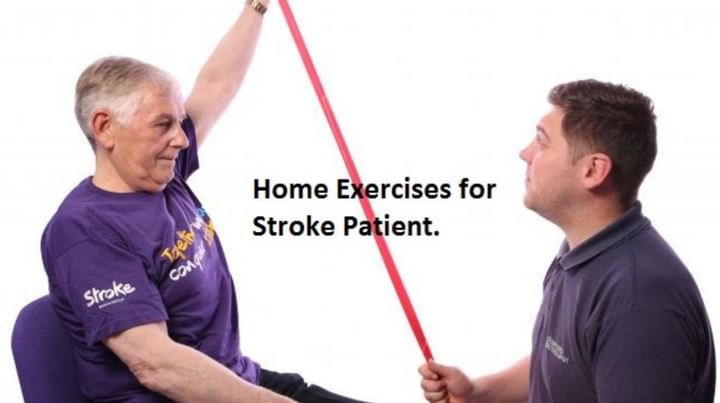Home Exercises for Stroke Patients
EXERCISES TO IMPROVE THE PATIENT’S GAIT
Full dorsiflexion of ankle and toes is essential for normal walking and for heel-toe strike.Moving patient backwards, normal dorsiflexion of sound right foot.Weight bearing and balance reactions facilitated on affected side.Standing with legs crossed for weight bearing of affected leg and balance reactions.
Stepping backwards with affected leg, getting heel to ground, balancing and weight transfer to affected leg.Walking with arms held backwards in extension.
This helps towards extension of hip before making a step with sound leg.Working for dorsiflexion of the affected foot while patient steps forward with sound leg.Moving a small trolley backwards and forward with affected leg.
EXERCISES THE PATIENT SHOULD DO AT HOME
Before the patient leaves hospital, a relative should be well instructed and trained with regard to his general management as well as being able to help him with his exercises.
The following exercises can eventually be done by the patient without the help of the therapist, and should be done at home as often as possible during the day to supplement treatment.The patient clasps his hands and interlocks his fingers, with the thumb of the affected hand over that of the sound one, to ensure as much abduction of the thumb as possible. His wrist should be in semi supination and extended. Pronation of the affected forearm must be avoided.In sitting or standing, he moves his hands above his head.
The elbows must beat the same level and the affected arm should not pull forward at the shoulder.This is followed by putting his clasped hands behind his head and then raising them again.
Next he puts his clasped hands on his chest, making sure that the affected arm does not pull backwards or drop down. From having his hands on his chest, he extends his arms forward so that his hands touch a wall or a mirror on the wall. The affected arm tends always to be lower than the sound one because of depression of the shoulder, and this should be counteracted.
If he finds this difficult he should lift his arms up again above his head and bend his trunk sideways towards the sound side in order to release the downward pull of the side flexors of the affected side of his trunk and shoulder girdle. Then he should again move his extended arms forward against a wall and he will now find that it is easier to hold the affected arm up at the same level as the sound one.
Exercises with clasped hands to improve extension of wrist and fingers can be done by the patient turning his clasped hands so that the palms face forwards, the back of his hands against his chest. He then extends his arms above his head, back to his chest, and forward against a mirror or wall. Shoulders and elbows should be level.
With his hands now flat against the wall, he slides them up and down and sideways towards the sounds side, the latter to help the forward movement of his affected shoulder. While standing, he can also place his hands down on a table and support himself on them.
Keeping his hands on the table, he walks backwards to obtain a good stretch of his trunk with his shoulders forward and he then walks forward again, still supported on his hands. When he can do this with his hands clasped, he can practice standing in front of a wall with his open hands placed flat against it. When doing this in treatment, the therapist should help him to abduct his thumb and spread his extended fingers.
Then he bends and extends his elbows, his hands remaining extended against the wall.When he is able to keep his affected hand his affected hand against the wall,he can turn his sound side away from it, the affected hand remaining on the wall, the elbow extended and the arm in horizontal abduction, in this way actively inhibiting flexor spasticity.
There are infinite variations of the above techniques which the therapist can invent and which will make treatment for the patient more interesting.Elevation of arms with clasped hands prior to placing hands on head.
With raised arms, patient turns clasped hands so that the palms face upwards and forward. The same movement with arms forward.Walking backwards while keeping palms on table, either with hands clasped or palms down.Standing with arms raised and hands against the wall with palms flat.



+1.svg)
